Maybe Arnim Zola?
And now, a message from Marvel’s most-masked character:
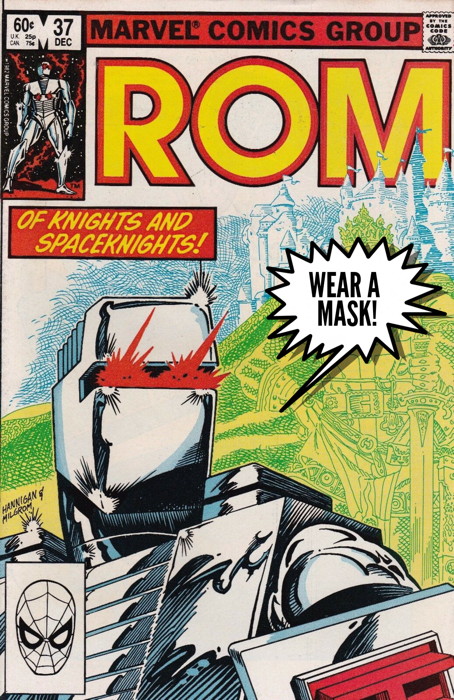
…though I suppose one could make the argument that Baron Zemo is even more masked, as his was permanently glued on or something. But ROM’s was, like, literally bolted to his skull, presumably. Anyway, I’m sure there are other contenders over at the House of Mask Ideas. This just popped up from a Twitter exchange between me and pal Cathy.
So on Wednesday’s post, Turan points out the rather spurious use of “anniversary” in relation to celebrations of comics hitting those Magical Round Numbers, usually multiples of 50 or 100. “Anniversary,” for example, is used correctly on this X-Men issue, as, while it was issue #175 (kinda of an oddball number for a special issue in those days, but fine) it was also literally the 20th anniversary of the title’s debut in 1963:
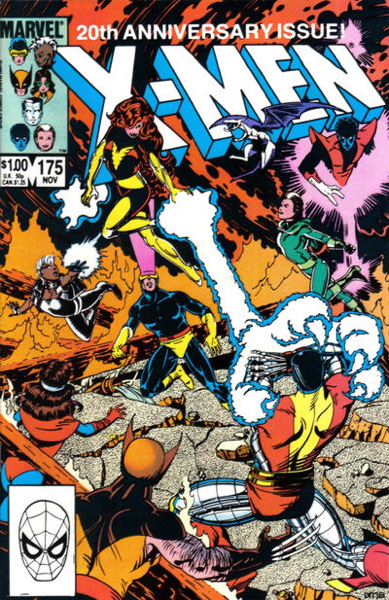
Whereas Spidery-Sam’s solo title had only been around for less than a decade when they called this issue “the 100th anniversary” special:
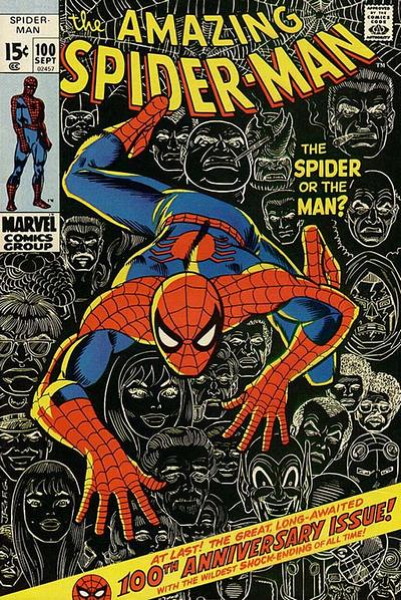
And as Turan says, there’s no equally-accepted alternative, as a lot of terms like “sesquicentennial” (actually, 150 years) are still tied to, well, years, as you just saw.
However, good news everyone! The Merriam-Webster dictionary, and a couple other sources, cut us comic fans a little slack in anniversary’s definition:
“broadly : a date that follows such an event by a specified period of time measured in units other than years”
I mean, what are issue numbers but counting off months (or 9-times-a-year early on, or like bi-weekly for some modern Marvels) one at a time? That “100th Anniversary Issue” of Amazing Spider-Man could be celebrating its 100th month (more or less) of publication.
On the other hand, every issue is pretty much an anniversary issue of some sort. That Spider-Man? “Special 8th Anniversary Celebration!” But it’s kind of a moot point anyway, as I can’t remember any recent examples of Marvel or DC blurbing a comic as an “anniversary issue” that wasn’t literally for something in its 10th, 20th, or 80th year of existence.
But I wouldn’t worry too much about calling issue #100 of something an “anniversary” issue. It’s too built into the parlance of comics fans that, really, we all know what we’re talking about when we say that. No biggie.
It did remind me of a weird anomaly from ’80s Marvel, though. Issue #296 of Fantastic Four was an extra-sized 25th anniversary issue:
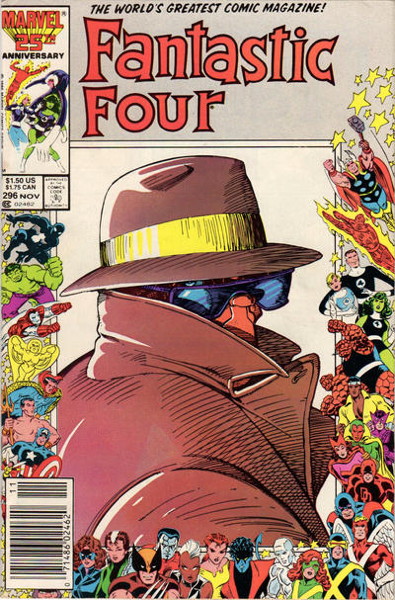
…but issue #300, just a few months later, was a plain ol’ regular-sized issue (with, granted, the momentous marriage of Johnny and Alicia…or is it?):
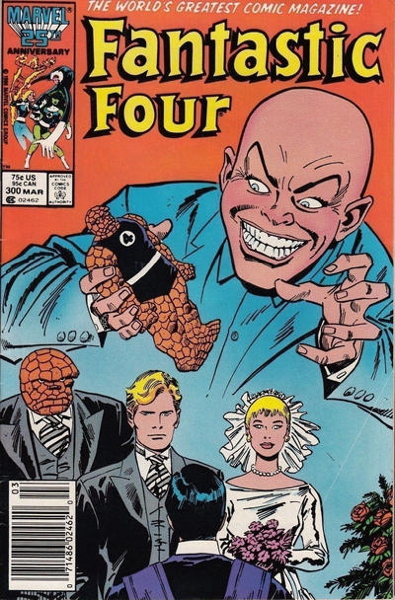
Now, all these years later, there’s no way that Marvel would have stood for this, and insisted both 296 and 300 be $9.99 giants, but I both appreciate and am surpised by the restrain shown. Alas, the 25th anniversary celebration couldn’t be saved until #300, as its cover date would have been March 1987 and putting it out of the 25th year. (Even though 300 technically was released in late November of ’86. OH, COVER DATES)
But hey, folks are dropping their own suggestions for great anniversary (sorry, Turan!) issues into the comments on Wednesday’s post, so feel free to add your own. Maybe I’ll comment on those in a future post.








I hope someone in Mexico had the wit to recruit the luchador Mil Mascaras to do a “Wear a Mask!” PSA.
His name translates as “Thousand Masks,” and his gimmick is that, well, he has a lot of masks. In those wonderfully bizarre movies in which he (sometimes in support of Santo and Blue Demon, sometimes as the leader of his own team) fights monsters and witches and alien invaders, this means that he tends to turn up wearing a different mask in each scene, without explanation.
I feel obligated to note that there was one brief shining moment in the late ’60s when DC did distinguish between the anniversary issue and the big round number issue. BATMAN #200 (March 1968) is the “200th Smash Issue,” commemorating the milestone with a cover that contains smaller versions of several previous covers, and a story in which the origins of Batman and Robin are recapitulated, and several classic villains–including, of course, Killer Moth–put in brief appearances). The next year, DETECTIVE COMICS #387 was “Batman’s 30th Anniversary Issue,” with a cover in which Batman holds up giant copies of DETECTIVE #27 and BATMAN #1; inside, his first appearance is both reprinted and retold (in an embarrassingly “updated” style, with Batman going out of his way to let us know he has heard of Janis Joplin).
Hey, that is the word we need for describing the big round number issues–milestone. It fits perfectly, the purpose of a milestone being to declare that a certain distance has been covered.
I realize that the fact that there is a comics line actually called Milestone does create some possibility for confusion.
No one is more masked than DOOM! Doom laughs at the puny masks of Rom and Zola!
I thought I should throw in the fact that, thirteen months after DETECTIVE COMICS #387 came #400, and this similarly was billed as the “400th Smash Issue!” rather than an anniversary. Interestingly, apart from that banner above the logo, the cover does not make anything of the occasion. Indeed, depending on how you regard the debut of Man-Bat, the only thing “special” about the issue is the back-up: at this point, Robin and Batgirl were alternating in the back-up spot, but for this issue they teamed up.
(Because every comics character has passionate fans, I should perhaps explain that I am not denigrating Man-Bat. There just does not happen to be any inherent reason for this story to be in the 400th issue, rather than the 399th or the 401st.)
I am surely over-staying my welcome here, but I got interested in how Marvel and DC generally dealt with milestone issues (that is the term I am going to use; go ahead and sue me, Denys Cowan) in the 1960s. I spent some idle moments at comics.org, with these results:
With Marvel the matter is simple, because as best I can tell, the company managed only five 100th issues in that decade. Three of these–MILLIE THE MODEL, JOURNEY INTO MYSTERY, and STRANGE TALES–are ordinary issues that make nothing at all of the nice round number. (In the case of STRANGE TALES, it was the next issue that was the big deal, when the Human Torch took over.) TALES TO ASTONISH #100 is a special issue–instead of the usual set-up of a 12-page Sub-Mariner story followed by a 10-page Hulk story, we get a 22-page story featuring both characters–but, oddly to modern eyes, the cover makes no mention of the issue number being an occasion. As for CAPTAIN AMERICA #100, that is promoted not as a 100th issue but as a first–“Big Premiere Issue!,” to use the actual words. That is because the previous 99 had been called TALES OF SUSPENSE.
DC generally had three approaches: covers that made no mention of the milestones, but did showcase special stories (e.g., ACTION COMICS #300, ADVENTURE COMICS #300, SUPERMAN #200); covers that mentioned the milestones, but were otherwise regular covers for issues (e.g., THE ADVENTURES OF JERRY LEWIS #100, OUR ARMY AT WAR #100 and #200); and covers that made no acknowledgment beyond that of the actual issue number (e.g. BLACKHAWK #200, HOUSE OF MYSTERY #100, G.I. COMBAT #100, OUR FIGHTING FORCES #100, ADVENTURES OF BOB HOPE #100, THE FOX AND THE CROW #100). BATMAN #200, as mentioned, made a quite a fuss of the occasion, both on the cover and in the interior story. The sign of things to come is SUPERMAN’S PAL JIMMY OLSEN #100, which is emblazoned with the logo “Special 100th Anniversary Issue!”
That would become more common in the 1970s, for example with ACTION COMICS #400 in 1971 being promoted as a “Special 400th Anniversary Issue.” Interestingly, ADVENTURE COMICS #400 (December 1970) calls itself on the cover “The 35th Anniversary–400th Issue,” and that is correct: the first issue was dated December 1935 (let us not quibble over its title being NEW COMICS, not ADVENTURE).
Enough.
I think from now on, taking a cue from Lewis Carroll, Marvel should celebrate non-anniversaries.
It is the only way to make everyone happy.
So, each issue, except a rare month, will be billed as an extra-special non-anniversary issue which Marvel can charge us $9.99.
When an anniversary issue does come around, Marvel will not advertise it and drop the price back to $3.99 for that month.
Oh, wait. Did I accidentally write “make everyone happy”? I meant make solely Marvel happy.
Mad Marketer: “Why, imagine celebrating an anniversary only every few years.”
“A very, very merry non-anniversary to you!”
how the hell did MILLIE THE MODEL make it to 100 issues??
Shouldn’t ROM be saying “Wear A Helmet!”?
Mr. Shark, MILLIE THE MODEL actually made it to 207 issues–with twelve annuals, fourteen issues of A DATE WITH MILLIE (actually, two series with that title, each of which ran seven issues), sixteen issues of MAD ABOUT MILLIE (plus an annual), 13 issues of LIFE WITH MILLIE, 34 issues of MODELING WITH MILLLIE, and 26 issues of MILLIE’S RED-HEADED RIVAL CHILI. Plus that tiny booklet that was sold through gumball machines (and was recently reprinted by the art book publisher Abrams).
The fan focus on super-hero comics tends to seriously distort the history of the medium.
Following up on that last point: I am reminded of an exchange I had a few years ago on another forum, when someone dismissed Congo Bill as a minor, unpopular character, while including Doctor Fate as one of DC’s major characters of the 1940s. I pointed out that Congo Bill had an unbroken run of 21 years (including a comic of his own), and was featured in a movie serial), while Dr. Fate’s original series ran only four years. That made no impression on him. Doctor Fate was a super-hero, and a member of the Justice Society–as far as this guy was concerned, that made him a major character. No non-super character could possibly matter as much.
I realize that I short-changed Millie a bit: she also had a ten-issue run in COMEDY COMICS.
So, here is a character who appeared regularly in print for 28 years, always headlining her own comic, usually appearing in multiple titles. There were sporadic appearances for two years after that. By any standard, she should be considered one of Marvel’s most important characters, and should be featured prominently in histories of the company. However, she was not a superhero, and most of her readers were female, so she is largely ignored; when she is mentioned, it is in the sneering, condescending way Mr. Shark used (“Can you believe people were once stupid enough to read this garbage? Thankfully, we are smarter than that now.”)
I mean, Dr. Droom is considered a more important character. His series ran for only five stories, totaling 25 pages, and he was never even mentioned on the covers. However, he was a superhero, and so he counts.
“Mr. Shark, MILLIE THE MODEL actually made it to 207 issues”
HOLY SHIT!
“it is in the sneering, condescending way Mr. Shark used”
I don’t believe I was SNEERING, just surprised!
Douglas Wolk’s new book (All of the Marvels) makes a pretty compelling argument that Marvel’s “career girl” comics (including Millie the Model) are the beginning of the current Marvel universe.
There was even a crossover between Patsy Walker and Millie’s books and Linda Carter, Student Nurse (who eventually became Night Nurse, doctor to superheroes). It’s a good read.
Thom H: “All of the Marvels”
Sounds good!